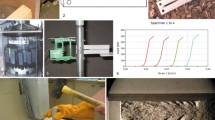Abstract
Young’s modulus and Poisson’s ratio for thermal spray coatings are needed to evaluate properties and characteristics of thermal spray coatings such as residual stresses, fracture toughness, and fatigue crack growth rates. It is difficult to evaluate Young’s modulus and Poisson’s ratio of thermal spray coatings be-cause coatings are usually thin and attached to a thicker and much stiffer substrate. Under loading, the substrate restricts the coating from deforming. Since coatings are used while bonded to a substrate, it is desirable to have a procedure to evaluate Young’s modulus and Poisson’s ratio in situ.
The cantilever beam method to evaluate the Young’s modulus and Poisson’s ratio of thermal spray coat-ings is presented. The method uses strain gages located on the coating and substrate surfaces. A series of increasing loads is applied to the end of the cantilever beam. The moment at the gaged section is calcu-lated. Using a laminated plate bending theory, the Young’s modulus and Poisson’s ratio are inferred based on a least squares fit of the equilibrium equations. The method is verified by comparing predicted values of Young’s modulus and Poisson’s ratio with reference values from a three-dimensional finite ele-ment analysis of the thermal spray coated cantilever beam. The sensitivity of the method is examined with respect to the accuracy of measured quantities such as strain gage readings, specimen dimensions, ap-plied bending moment, and substrate mechanical properties. The method is applied to evaluate the Young’s modulus and Poisson’s ratio of four thermal spray coatings of industrial importance.
Similar content being viewed by others
Abbreviations
- εXCG :
-
Longitudinal strain gage reading on coating
- εYCG :
-
Transverse strain gage reading on coating
- εXSG :
-
Longitudinal strain gage reading on substrate
- εysg :
-
Transverse strain gage reading on substrate
- εXCI :
-
Longitudinal strain at coating interface
- εYCI :
-
Transverse strain at coating interface
- εXSI :
-
Longitudinal strain at substrate interface
- εYSI :
-
Transverse strain at substrate interface
- σXCG :
-
Longitudinal stress on coating surface
- σycg :
-
Transverse stress on coating surface
- σxsg :
-
Longitudinal stress on substrate surface
- σYSG :
-
Transverse stress on substrate surface
- σXCI :
-
Longitudinal stress at coating interface
- σYCIl :
-
Transverse stress at coating interface
- σXSI :
-
Longitudinal stress at substrate interface
- σYSI :
-
Transverse stress at substrate interface
- H :
-
Thickness of substrate
- T c :
-
Thickness of coating
- b :
-
Width of the specimen
- E c :
-
Young’s modulus of the coating
- vc :
-
Poisson’s ratio of the coating
- E s :
-
Young’s modulus of the substrate
- vs :
-
Poisson’s ratio of the substrate
- P :
-
Applied load
- M :
-
Applied bending moment at gaged locations
References
D. Greving, J. Shadley, and E. Rybicki, Effects of Coating Thickness and Residual Stresses on the Bond Strength of ASTM C633-79 Thermal Spray Coating Test Specimens,J. Therm. Spray Technol., Vol 3 (No. 4), 1994, p 371–378
M. Hobbs, R. Cooke, B. Harris, and H. Reiter, Surface Residual Stresses in Thermal Barrier Coatings,Br. Ceram. Proc, Vol 39, 1987, p 119–141
D. Jordan and K. Faber, X-Ray Residual Stress Analysis of a Ceramic Thermal Barrier Coating Undergoing Thermal Cycling,Thin Solid Films, Vol 235, 1993, p 137–141
Whitney and G. Stenger, A Device for Implementing the Strain Gage Hole Drilling Method of Residual Stress Measurement on Aircraft Transparencies,Exp. Tech., July/August, 1993, p 25–30
D. Greving, E. Rybicki, and J. Shadley, Through-Thickness Residual Stress Evaluations for Some Thermal Spray Coatings of Industrial Im- portance Using the Modified Layer Removal Method,J. Therm. Spray Technol., Vol 3 (No. 4), 1994, p 379–388
R. Knight and R.W. Smith, Residual Stress in Thermally Sprayed Coat- ings,Thermal Spray Coatings: Research, Design and Applications, C.C. Berndt and TF.Bernecki, Ed., ASM International, 1993, p 607–612
R. Jones,Mechanics of Composite Materials, Hemisphere Publish- ing Corp., 1975
J. Holman,Experimental Methods for Engineers, McGraw-Hill, Inc., 1978
H.-D. Steffens and U. Fischer, Correlation Between Microstructure and Physical Properties of Plasma Sprayed Zirconia Coatings,Thermal Spray Technology—New Ideas and Processes, D.L. Houck, Ed., ASM International, 1988, p 167–173
X. Provot, H. Burlet, M. Vardavoulias, M. Jeandin, D. Manesse, C. Richard, and J. Lu, Comparative Studies of Microstructure, Residual Stress Distributions and Wear Properties for HVOF and APS WCCo Coatings of Ti6A14V,Thermal Spray Coatings: Research, Design and Applications, C.C. Berndt and T.F. Bernecki, Ed., ASM International, 1993, p 159–166
Author information
Authors and Affiliations
Rights and permissions
About this article
Cite this article
Rybicki, E.F., Shadley, J.R., Xiong, Y. et al. A cantilever beam method for evaluating Young’s modulus and Poisson’s ratio of thermal spray coatings. JTST 4, 377–383 (1995). https://doi.org/10.1007/BF02648639
Issue Date:
DOI: https://doi.org/10.1007/BF02648639




